Sustainable Development Goal 17
Revitalize the global partnership for sustainable development
Sustainable Development Goal 17 is to “revitalize the global partnership for sustainable development”, according to the United Nations.
The visualizations and data below present the global perspective on where the world stands today and how it has changed over time.
The UN has defined 19 targets and 25 indicators for SDG 17. Targets specify the goals and indicators represent the metrics by which the world aims to track whether these targets are achieved. Below we quote the original text of all targets and show the data on the agreed indicators.
List of targets and indicators
Target 17.1Mobilize resources to improve domestic revenue collection
SDG Indicator 17.1.1Government revenue
Definition of the SDG indicator: Indicator 17.1.1 is “total government revenue as a proportion of GDP, by source” in the UN SDG framework.
Data for this indicator is shown in the interactive visualization.
Because budgetary accounts may not include all central government units (such as social security funds), they usually provide an incomplete picture. In federal states the central government accounts provide an incomplete view of total public finance.
Target: “Strengthen domestic resource mobilization, to improve domestic capacity for tax and other revenue collection” across all countries by 2030.
More research: Further data and research on this topic is available at the Our World in Data topic pages on Government Spending and Taxation.

SDG Indicator 17.1.2Domestic taxes
Definition of the SDG indicator: Indicator 17.1.2 is the “proportion of domestic budget funded by domestic taxes” in the UN SDG framework.
Data for this indicator is shown in the interactive visualization.
Target: “Strengthen domestic resource mobilization, to improve domestic capacity for tax and other revenue collection” across all countries by 2030.
More research: Further data and research on this topic is available at the Our World in Data topic page on Government Spending and Taxation.
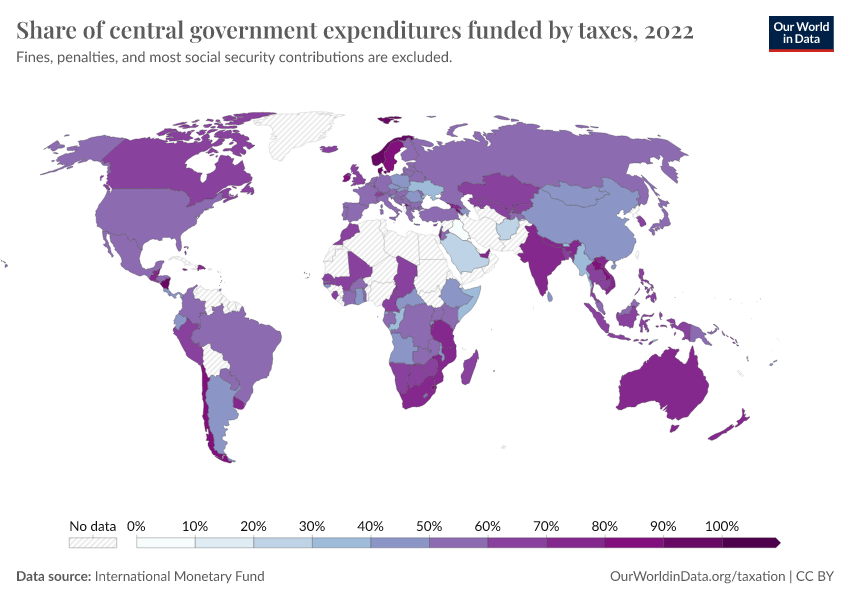
Target 17.2Implement all development assistance commitments
SDG Indicator 17.2.1Development assistance to least-developed countries
Definition of the SDG indicator: Indicator 17.2.1 is “net official development assistance, as a proportion of the Organization for Economic Cooperation and Development (OECD) Development Assistance Committee donors’ gross national income (GNI)” in the UN SDG framework.
Data for this indicator is shown in the first interactive visualization, with the ODA specifically allocated to least-developed countries (LDCs) shown in the second visualization.
Official development assistance refers to flows to countries and territories on the Organization for Economic Co-operation and Development’s Development Assistance Committee (DAC) and to multilateral institutions which meet a set of criteria related to the source of the funding, the purpose of the transaction, and the concessional nature of the funding.
Target: “Developed countries to implement fully their official development assistance commitments, including the commitment by many developed countries to achieve the target of 0.7 per cent of gross national income for official development assistance (ODA/GNI) to developing countries and 0.15 to 0.20 per cent of ODA/GNI to least developed countries.”

Target 17.3Mobilize financial resources for developing countries
SDG Indicator 17.3.1Foreign direct investment
Definition of the SDG indicator: Indicator 17.3.1 is “Additional financial resources mobilized for developing countries from multiple sources” in the UN SDG framework.
Data for this indicator is shown in the interactive visualization as foreign direct investment outflows and inflows as a share of GDP.
Target: “Mobilize additional financial resources for developing countries from multiple sources” by 2030.
A specific target level of financial resource mobilization is not provided for this indicator.
More research: Further data and research on this topic is available at the Our World in Data topic page on Trade and Globalization.
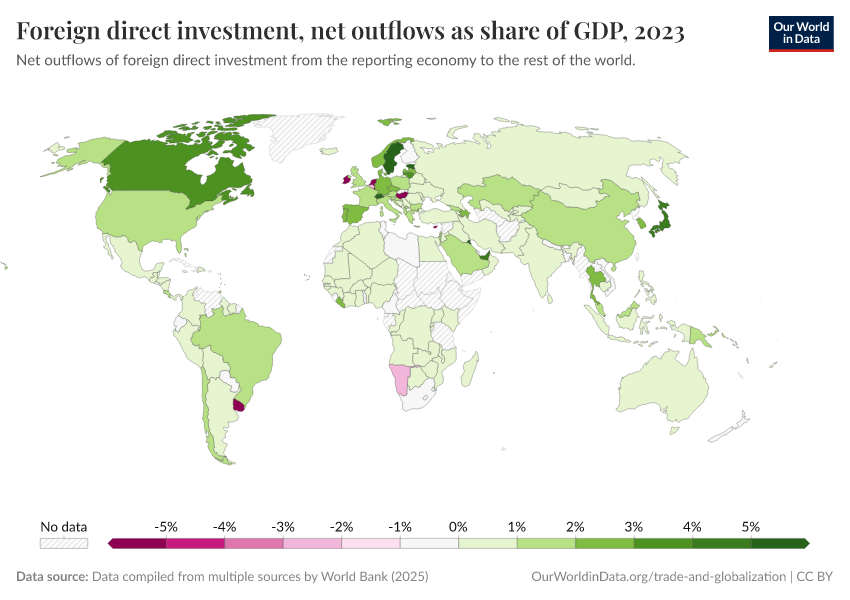
SDG Indicator 17.3.2Volume of remittances
Definition of the SDG indicator: Indicator 17.3.2 is the “volume of remittances (in United States dollars) as a proportion of total GDP” in the UN SDG framework.
Personal remittances comprise personal transfers and compensation of employees. Personal transfers consist of all current transfers in cash or in kind made or received by resident households to or from nonresident households. Compensation of employees refers to the income of border, seasonal, and other short-term workers who are employed in an economy where they are not resident and of residents employed by nonresident entities.
Data for this indicator is shown in the interactive visualization.
Target: “Mobilize additional financial resources for developing countries from multiple sources” by 2030.
A specific target level of financial resource mobilization is not provided for this indicator.
More research: Further data and research on this topic is available at the Our World in Data topic page on Trade and Globalization.
Target 17.4Assist developing countries in attaining debt sustainability
SDG Indicator 17.4.1Debt service
Definition of the SDG indicator: Indicator 17.4.1 is “debt service as a proportion of exports of goods and services” in the UN SDG framework.
Total debt service is the sum of principal repayments and interest actually paid in currency, goods, or services on long-term debt, interest paid on short-term debt, and repayments (repurchases and charges) to the IMF. This indicator measures total debt service as a share of a country’s exports of goods and services.
Data for this indicator is shown in the interactive visualization.
Target: “Assist developing countries in attaining long-term debt sustainability through coordinated policies aimed at fostering debt financing, debt relief and debt restructuring” by 2030.1

Target 17.5Invest in least-developed countries
SDG Indicator 17.5.1Investment promotion for least-developed countries
Definition of the SDG indicator: Indicator 17.5.1 is the “number of countries that adopt and implement investment promotion regimes for developing countries, including the least developed countries” in the UN SDG framework.
Instruments that promote outward foreign investment in developing countries can include investment guarantees, financial or fiscal support for outward investment, international investment agreements, and information and other advisory services for outward investments.
Currently, only data on bilateral investment treaties is available. Data on signed and in-force bilateral investment treaties is shown in the interactive visualizations.
Target: “Adopt and implement investment promotion regimes for least developed countries” by 2030.
More research: Further data and research on this topic is available at the Our World in Data topic page on Trade and Globalization.

Target 17.6Knowledge sharing and cooperation for access to science, technology and innovation
SDG Indicator 17.6.1Fixed broadband subscriptions
Definition of the SDG indicator: Indicator 17.6.1 is “fixed Internet broadband subscriptions per 100 inhabitants, by speed” in the UN SDG framework.
Data on landline Internet subscriptions and broken down by speed is shown in the interactive visualizations.
Target: “Enhance North-South, South-South and triangular regional and international cooperation on and access to science, technology and innovation” by 2030.2
More research: Further data and research on this topic is available at the Our World in Data topic pages on Technology Change and the Internet.
Additional charts

Target 17.7Promote sustainable technologies to developing countries
SDG Indicator 17.7.1Sustainable technologies in developing countries
Definition of the SDG indicator: Indicator 17.7.1 is the “total amount of approved funding for developing countries to promote the development, transfer, dissemination and diffusion of environmentally sound technologies” in the UN SDG framework.
Environmentally Sound Technologies (ESTs) are technologies or systems that can have significantly higher environmental performance in comparison with other technologies, in terms of environmental protection, limiting pollution, and better addressing sustainability, recycling, and waste management.
This indicator is measured in terms of the total trade of tracked ESTs, which includes exports, imports, and re-exports and re-imports, as well as national investment in ESTs. Data on exports and imports of ESTs is shown in the interactive visualization.
Target: “Promote the development, transfer, dissemination and diffusion of environmentally sound technologies to developing countries” by 2030.3
More research: Further data and research on this topic is available at the Our World in Data topic page on Trade and Globalization.

Target 17.8Strengthen science, technology and innovation capacity for least-developed countries
SDG Indicator 17.8.1Individuals using the Internet
Definition of the SDG indicator: Indicator 17.8.1 is the “proportion of individuals using the Internet” in the UN SDG framework.
Data on this indicator is shown in the interactive visualization.
Target: “Fully operationalize the technology bank and science, technology and innovation capacity-building mechanism for least developed countries, in particular information and communications technology.”
More research: Further data and research on this topic is available at the Our World in Data topic pages on Technological Change and the Internet.
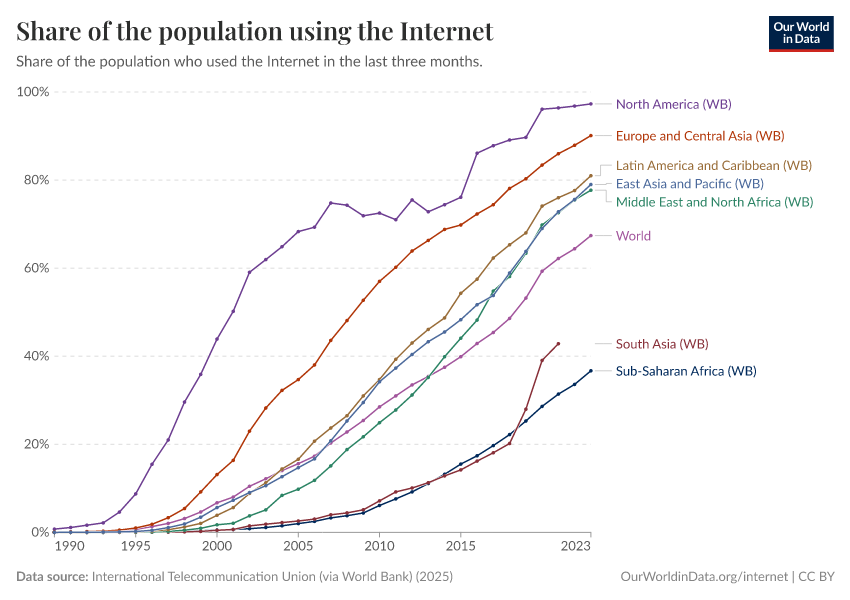
Target 17.9Enhanced SDG capacity in developing countries
SDG Indicator 17.9.1SDG support for developing countries
Definition of the SDG indicator: Indicator 17.9.1 is the “dollar value of financial and technical assistance (including through North-South, South-South and triangular cooperation) committed to developing countries” in the UN SDG framework.
This indicator is measured as gross official development assistance (ODA) from all donors for capacity building and national planning.
In the interactive visualization, this is shown as total ODA for technical co-operation.
Target: “Enhance international support for implementing effective and targeted capacity-building in developing countries to support national plans to implement all the Sustainable Development Goals” through 2030.”4

Target 17.10Promote a universal trading system under the WTO
SDG Indicator 17.10.1Weighted average tariffs
Definition of the SDG indicator: Indicator 17.10.1 is the “worldwide weighted tariff-average” in the UN SDG framework.
Data on this indicator is shown in the interactive visualization as the weighted mean tariff applied across all products.
Target: “Promote a universal, rules-based, open, non-discriminatory and equitable multilateral trading system under the World Trade Organization” by 2030.5
More research: Further data and research on this topic is available at the Our World in Data topic page on Trade and Globalization.
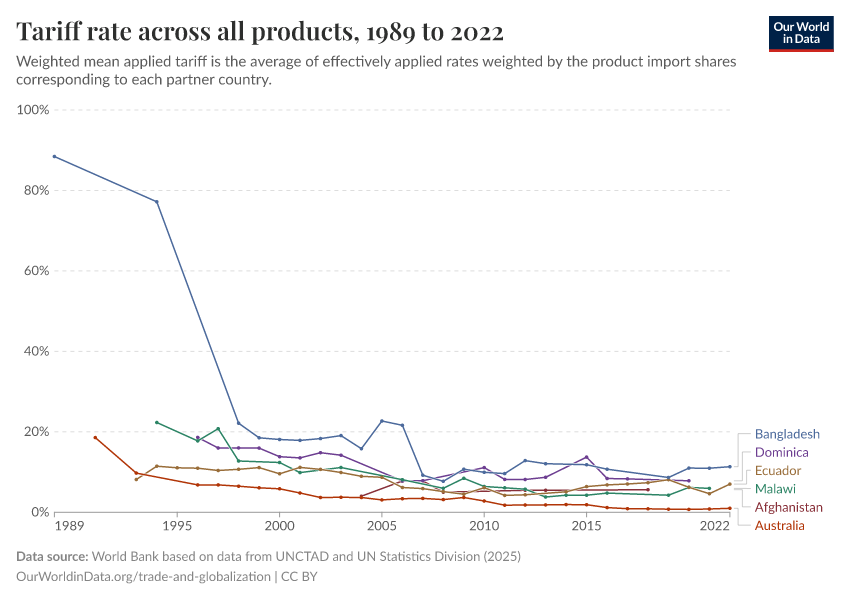
Target 17.11Increase the exports of developing countries
SDG Indicator 17.11.1Exports from developing countries
Definition of the SDG indicator: Indicator 17.11.1 is “developing countries’ and least developed countries’ share of global exports” in the UN SDG framework.
Data on this indicator for exports of merchandise and services is shown in the interactive visualizations, alongside the value of exported goods and services.
Target: “Significantly increase the exports of developing countries, in particular with a view to doubling the least developed countries’ share of global exports by 2020.”
Unlike most SDG targets which are set for the year 2030, this indicator was to be achieved by 2020.
More research: Further data and research on this topic is available at the Our World in Data topic page on International Trade.

Target 17.12Remove trade barriers for least-developed countries
SDG Indicator 17.12.1Tariffs for developing countries
Definition of the SDG indicator: Indicator 17.12.1 is the “weighted average tariffs faced by developing countries, least developed countries and small island developing States” in the UN SDG framework.
This indicator is measured as the average import tariffs experienced by exports from developing countries, least developed countries, and small island developing States.
Since internationally comparable data is not currently available for this indicator, this is shown in the interactive visualization as the average import tariffs in each country, additionally disaggregated by primary and manufactured products.
Target: “Realize timely implementation of duty-free and quota-free market access on a lasting basis for all least developed countries.”6
More research: Further data and research on this topic is available at the Our World in Data topic page on Trade and Globalization.
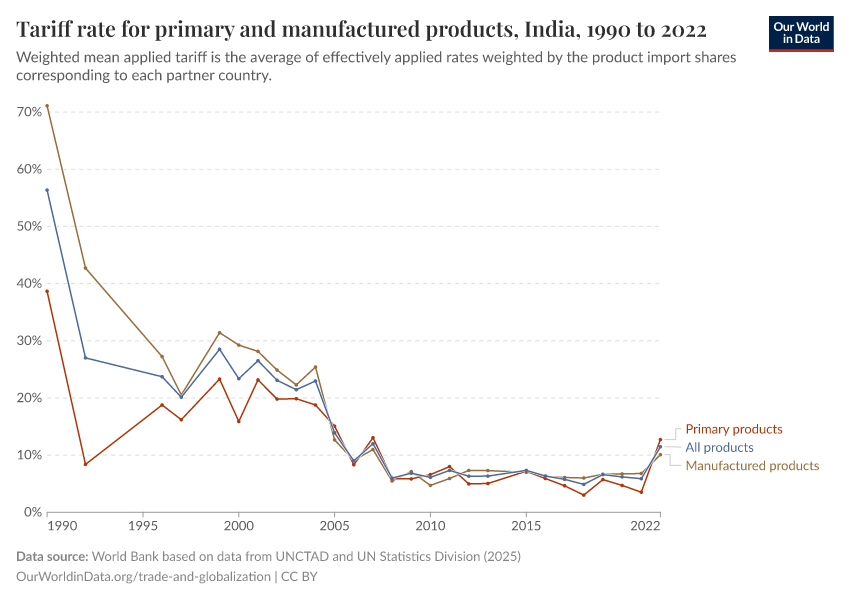
Target 17.13Enhance global macroeconomic stability
SDG Indicator 17.13.1Macroeconomic Dashboard
Definition of the SDG indicator: Indicator 17.13.1 is the “Macroeconomic Dashboard” in the UN SDG framework.
The Macroeconomic Dashboard refers to a set of indicators used to monitor a country’s economic condition, with measures focused on a country’s trade and balance of payments, fiscal policy, gross domestic product, financial sector, and unemployment rate.
The interactive visualization shows data on three of these indicators: consumer price inflation, gross public sector debt, and merchandise trade.
Target: “Enhance global macroeconomic stability, including through policy coordination and policy coherence.”

Target 17.14Enhance policy coherence for sustainable development
SDG Indicator 17.14.1Policy for sustainable development
Definition of the SDG indicator: Indicator 17.14.1 is the “number of countries with mechanisms in place to enhance policy coherence of sustainable development” in the UN SDG framework.
Although the indicator is defined in terms of the number of countries, in practice it is measured in terms of an implementation score for mechanisms in place to enhance policy coherence for sustainable development.
Data on this indicator is shown in the interactive visualization.
Target: “Enhance policy coherence for sustainable development” through 2030.

Target 17.15Respect national leadership to implement policies for sustainable development
SDG Indicator 17.15.1National results frameworks
Definition of the SDG indicator: Indicator 17.15.1 is the “extent of use of country-owned results frameworks and planning tools by providers of development cooperation” in the UN SDG framework.
Data on this indicator is shown in the interactive visualization.
Target: “Respect each country’s policy space and leadership to establish and implement policies for poverty eradication and sustainable development” through 2030.

Target 17.16Enhance the global partnership for sustainable development
SDG Indicator 17.16.1Progress in multistakeholder development
Definition of the SDG indicator: Indicator 17.16.1 is the “number of countries reporting progress in multi-stakeholder development effectiveness monitoring frameworks that support the achievement of the Sustainable Development Goals” in the UN SDG framework.
Data for this indicator is shown in the interactive visualization for framework providers and recipients.
Target: “Enhance the Global Partnership for Sustainable Development, complemented by multi-stakeholder partnerships that mobilize and share knowledge, expertise, technology and financial resources, to support the achievement of the Sustainable Development Goals in all countries, in particular developing countries” by 2030.
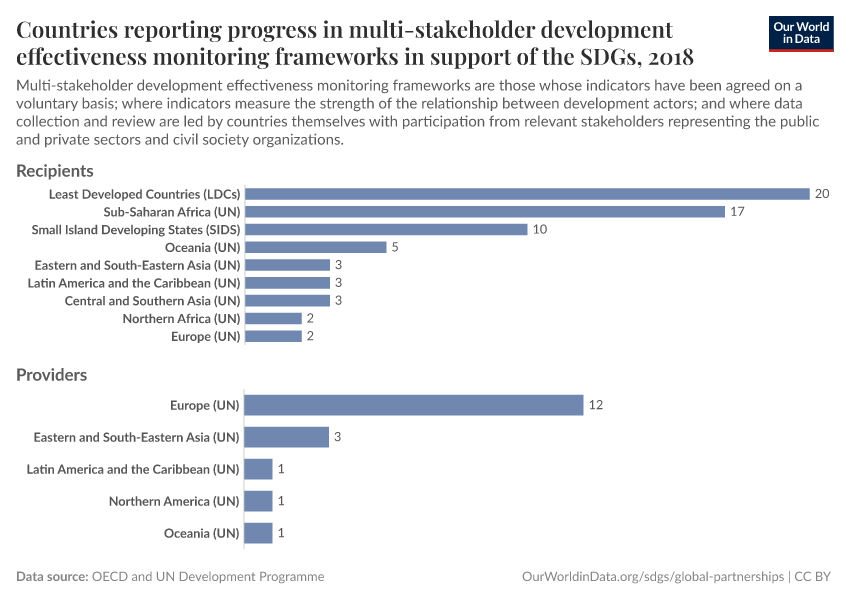
Target 17.17Encourage effective partnerships
SDG Indicator 17.17.1Public, private and civil society partnerships
Definition of the SDG indicator: Indicator 17.17.1 is the “amount in United States dollars committed to public-private partnerships for infrastructure” in the UN SDG framework.
Infrastructure in this context refers to energy, information and communications technology, transport, and water-related infrastructure.
Data for this indicator is shown in the interactive visualization.
Target: “Encourage and promote effective public, public- private and civil society partnerships, building on the experience and resourcing strategies of partnerships” by 2030.
More research: Related data on this indicator, specifically related to partnerships in infrastructure projects is available at the Our World in Data topic page on Government Spending.

Target 17.18Enhance availability of reliable data
SDG Indicator 17.18.1Statistical Capacity
Definition of the SDG indicator: Indicator 17.18.1 is the “statistical capacity indicator for Sustainable Development Goal monitoring” in the UN SDG framework.
This indicator is measured using the Statistical Capacity Indicator which provides an overview of the capacity of a country's national statistical system. Since the Statistical Capacity Indicator is currently under review, no data is reported here.
Target: “Enhance capacity-building support to developing countries, including for least developed countries and small island developing States, to increase significantly the availability of high-quality, timely and reliable data” in all countries by 2020.7
Unlike most SDGs which have a target year of 2030, this indicator was to be achieved by 2020.
No data for this indicator
We are currently not aware of data for this indicator. You can notify us of available data for this indicator via our feedback form.
SDG Indicator 17.18.2National statistical legislation
Definition of the SDG indicator: Indicator 17.18.2 is the “number of countries that have national statistical legislation that complies with the Fundamental Principles of Official Statistics” in the UN SDG framework.
The Fundamental Principles of Official Statistics refer to a set of 10 principles adopted by the United Nations Statistical Commission to guide national statistical agencies in the key technical and ethical considerations involved in their work.
Data on this indicator is shown in the interactive visualization.
Target: “Enhance capacity-building support to developing countries, including for least developed countries and small island developing States, to increase significantly the availability of high-quality, timely and reliable data” in all countries by 2020.7
Unlike most SDGs which have a target year of 2030, this indicator was to be achieved by 2020.

SDG Indicator 17.18.3National statistical plans
Definition of the SDG indicator: Indicator 17.18.3 is the “number of countries with a national statistical plan that is fully funded and under implementation, by source of funding” in the UN SDG framework.
This indicator measures the number of countries with a fully-funded statistical plan, differentiated by source of funding.
Data for this indicator is shown in the interactive visualization.
Target: “Enhance capacity-building support to developing countries, including for least developed countries and small island developing States, to increase significantly the availability of high-quality, timely and reliable data” in all countries by 2020.7
Unlike most SDGs which have a target year of 2030, this indicator was to be achieved by 2020.

Target 17.19Further develop measurements of progress
SDG Indicator 17.19.1Resources for statistical capacity
Definition of the SDG indicator: Indicator 17.19.1 is the “dollar value of all resources made available to strengthen statistical capacity in developing countries” in the UN SDG framework.
Data on this indicator is shown in the interactive visualization.
Target: “By 2030, build on existing initiatives to develop measurements of progress on sustainable development that complement gross domestic product, and support statistical capacity-building in developing countries” in all countries by 2030.

SDG Indicator 17.19.2Completeness of census, birth and death registration
Definition of the SDG indicator: Indicator 17.19.2 is the “proportion of countries that (a) have conducted at least one population and housing census in the last 10 years; and (b) have achieved 100 percent birth registration and 80 per cent death registration” in the UN SDG framework.
Data for this indicator is shown in three interactive visualizations: the countries that have completed a population census in the last 10 years; the share of births that are registered; and the share of deaths that are registered.
Target: “By 2030, build on existing initiatives to develop measurements of progress on sustainable development that complement gross domestic product, and support statistical capacity-building in developing countries” in all countries by 2030.

Endnotes
Full text: “Assist developing countries in attaining long-term debt sustainability through coordinated policies aimed at fostering debt financing, debt relief and debt restructuring, as appropriate, and address the external debt of highly indebted poor countries to reduce debt distress.”
Full text: “Enhance North-South, South-South and triangular regional and international cooperation on and access to science, technology and innovation and enhance knowledge- sharing on mutually agreed terms, including through improved coordination among existing mechanisms, in particular at the United Nations level, and through a global technology facilitation mechanism.”
Full text: “Promote the development, transfer, dissemination and diffusion of environmentally sound technologies to developing countries on favourable terms, including on concessional and preferential terms, as mutually agreed.”
Full text: “Enhance international support for implementing effective and targeted capacity-building in developing countries to support national plans to implement all the Sustainable Development Goals, including through North- South, South-South and triangular cooperation.”
Full text: “Promote a universal, rules-based, open, non-discriminatory and equitable multilateral trading system under the World Trade Organization, including through the conclusion of negotiations under its Doha Development Agenda.”
Full text: “Realize timely implementation of duty-free and quota-free market access on a lasting basis for all least developed countries, consistent with World Trade Organization decisions, including by ensuring that preferential rules of origin applicable to imports from least developed countries are transparent and simple, and contribute to facilitating market access.”
Full text: “By 2020, enhance capacity-building support to developing countries, including for least developed countries and small island developing States, to increase significantly the availability of high-quality, timely and reliable data disaggregated by income, gender, age, race, ethnicity, migratory status, disability, geographic location and other characteristics relevant in national contexts.”
Cite this work
Our articles and data visualizations rely on work from many different people and organizations. When citing this article, please also cite the underlying data sources. This article can be cited as:
Our World in Data team (2023) - “Revitalize the global partnership for sustainable development” Published online at OurWorldinData.org. Retrieved from: 'https://archive.ourworldindata.org/20251220-152415/sdgs/global-partnerships.html' [Online Resource] (archived on December 20, 2025).BibTeX citation
@article{owid-sdgs-global-partnerships,
author = {Our World in Data team},
title = {Revitalize the global partnership for sustainable development},
journal = {Our World in Data},
year = {2023},
note = {https://archive.ourworldindata.org/20251220-152415/sdgs/global-partnerships.html}
}Reuse this work freely
All visualizations, data, and code produced by Our World in Data are completely open access under the Creative Commons BY license. You have the permission to use, distribute, and reproduce these in any medium, provided the source and authors are credited.
The data produced by third parties and made available by Our World in Data is subject to the license terms from the original third-party authors. We will always indicate the original source of the data in our documentation, so you should always check the license of any such third-party data before use and redistribution.
All of our charts can be embedded in any site.